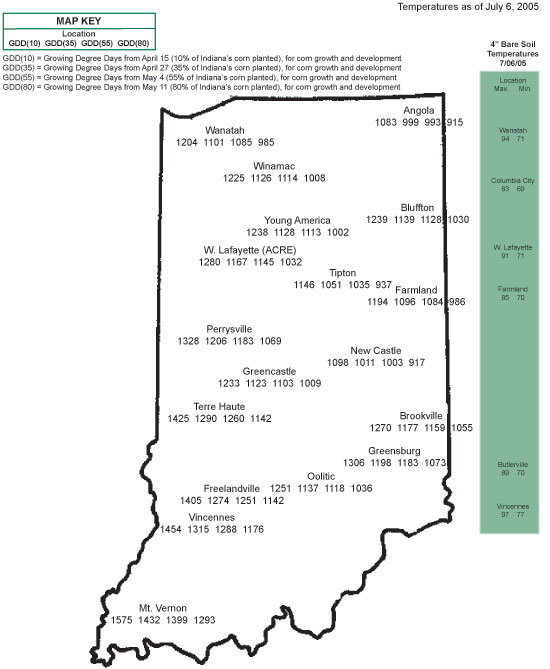Pest & Crop Newsletter, Entomology Extension, Purdue University
- Suggestive Behavior in the Corn Field: A Fast & Accurate Pregnancy Test for Corn
- Tassel Emergence & Pollen Shed
- Silk Emergence
Spider Mites, Rain, and Control – (John Obermeyer, Christian Krupke, and Larry Bledsoe)
- Rainfall has very little direct effect on spider mite populations.
- Rain and high humidity encourage beneficial fungal pathogens.
- Depending on future weather, rain may be a brief respite to spider mite damage and spread.
- Dimethoate is best to control mites, chlorpyrifos is best option when soybean aphid are also present.
Scattered thunderstorms have brought moisture relief to some parched areas of Indiana. Now the question concerning spider mites is whether the rain will “control” them. Before attempting to answer the question, let’s review the factors that have combined to create a spider mite problem in soybean fields.

Early strippling from spider mite feeding
Extended hot and dry conditions will:
- encourage the movement of spider mites from drying field margins into soybean
- favor rapid (sometimes explosive) reproduction of spider mites
- cause spider mites to increase their feeding rates, while also allowing greater nutrient uptake from stressed plants
- dramatically reduce fungal pathogens that normally keeping spider mites in check
In contrast, a significant rainfall (1 inch or more) followed by high humidity will:
- recharge the plant’s fluids, making them less to conducive to spider mites
- encourage the growth, development, and dissemination of beneficial fungal pathogens
- physically kill spider mites by dislodging them from the plant (this is relatively minor)
The bottom line here is that rainfall does not make the spider mites go away, it merely helps plants recover and slows down the reproductive rate of mite populations. Unless fungal pathogens wipe them out (given continual high humidity), they will lurk and may possibly return to an outbreak situation should the weather return to hot and dry. Spider mite damage is irreversible. That is, leaves that are severely bronzed or brown will not “green back up” and contribute to the yield of the field.
Two pesticides are recommended to control spider mites. These include dimethoate (Dimethoate 400 and 4 EC) and chlorpyrifos (Lorsban 4E). Dimethoate is the most efficacious of these compounds for mite control. If soybean aphid is also present in the field, then chlorpyrifos would be a good choice to suppress both pests. Neither of these products will control spider mite eggs, however, and each will provide about 7 to 10 days of residual activity. Proper placement of these pesticides is the key to successful control. Nozzle pressures of 40 psi with fine to medium droplet size and 30-40 gallons of water/acre for ground application helps distribute the pesticide throughout the foliage.
![]()
Corn Lodging Being Reported – (John Obermeyer, Christian Krupke, and Larry Bledsoe)
- Leaning corn plants may indicate rootworm feeding damage.
- Inspect for damage now before plants right themselves.
- Product representatives should investigate where damage is significant.

Equivalent of one nodal root destroyed by rootworm feeding.
Typically around this time of year, reports of corn lodging are received. A combination of rapid vegetative growth before brace root development and gusty winds topple corn plants with reduced root systems. Rootworm damage is one of several possible causes of poor anchoring of corn plants. If leaning is noticed in fields, now would be an excellent time to investigate the cause for these leaning plants.
Corn plants that have tilted and/or lodged should be dug, not pulled, and then inspected for root feeding scars and/or pruning. Pay particular attention to the nodes of roots just below the soil surface, these may have been completely destroyed and appear only as necrotic, hollowed areas. Producers that used products for rootworm protection should be contacting their dealer or manufacturer’s representative for further investigations. Fields with significant root damage will likely have high numbers of beetles as they emerge from the soil, see following article for more information.
![]()
Stressed Corn, Pollination, and Rootworm Beetles – (John Obermeyer, Christian Krupke, and Larry Bledsoe)
- Large numbers of rootworm beetles being reported in corn.
- Stressed corn and spotty pollination are making treatment decisions difficult.
- Length of silks and amount of pollen yet to fall is the key to fertilization.
Several calls have been received this week concerning the large numbers of western corn rootworm beetles in cornfields. Many plants within these fields are being discovered with damaged roots from larval damage. This, combined with our dry conditions at present, is resulting in severely stressed plants. Treatment decisions have been very difficult as the beetles flock to the actively pollinating plants occurring in spots within a field.

Minor rootworm beetle silk clipping.
When fields are pollinating evenly, control may be necessary if the silks are clipped off to within 1\2 inch or less of the tip of the ear before 50% pollination is completed. Don’t judge the need for treatment on beetle numbers … SILK DAMAGE is the ONLY relevant factor for making treatment decisions. Producers have noted the beetles all over the plants, not necessarily feeding on the silks. Many beetles are in the corn whorls before tassels emerge, they are doing some economically insignificant but “showy” leaf feeding. As the tassels emerge, beetles may be seen feeding on the anthers and pollen. The high-protein pollen is their preferred food. Plants under drought stress will often have the pollen shed and exhibit silking out of synchrony. Controlling beetles will only protect the silks that are still viable to receive pollen, so make certain that over half of the pollen hasn’t already been shed. Refer to Bob Nielsen’s related articles in Agronomy Tips of this week’s Pest&Crop.
Consider:
- Pollen is the rootworm beetles favorite food.
- Many times more than enough pollen is shed to fertilize ears and feed beetles.
- Silks a 1/2 inch or longer can successfully receive pollen.
- Silks can receive the pollen anywhere, not just the tip.
![]()
What’s Happening With Soybean Aphid? – (John Obermeyer, Christian Krupke, and Larry Bledsoe)
- Aphid numbers increasing but slower than anticipated.
- Mites are becoming a great concern in drought-stressed areas.
- Treating needlessly for soybean aphid could have disastrous consequences.

Live birth allows soybean aphid to multiply quickly
Reports throughout Indiana and the Midwest indicate that soybean aphid numbers are increasing, but slower than anticipated by some researcher. Some fields in the Midwest have reached the threshold of ≥250 aphids/plant and treatments have been applied. Aggressive marketing by a chemical company that shall remain nameless has convinced some producers to treat fields at very low infestations levels. Do not confuse the “Speed Sampling” www.soybeans.umn.edu/crop/insects/
aphid/aphid_sampling.htm numbers introduced by the University of Minnesota (NOT for use in Indiana yet – still being validated this year throughout the Midwest) with the established threshold of 250 aphids/plant.
Continual dry conditions in many areas of the Midwest have soybean pest concerns switching partially from aphids to spider mites. Those involved in field crop production in 1988 will recall the destructive potential of this sucking arthropod on drought-stressed crops (see preceding article for more details). Unwarranted applications of synthetic pyrethroids as a pre-threshold aphid treatment will do little for aphid control and may create mite “flaring.” This is a condition when natural predators are killed and spider mite egg production actually increases – leading to local population explosions in a very short period of time.
![]()
Click for Table.
Black Light Catch Report
![]()
Suggestive Behavior in the Corn Field: A Fast & Accurate Pregnancy Test for Corn - (Bob Nielsen)
- Silk clipping by insects can interfere with pollination success.
- Silks normally detach from fertilized ovules within days of successful pollination and thus can be used as an early indicator of pollination progress and/or success.
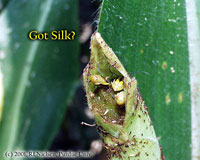
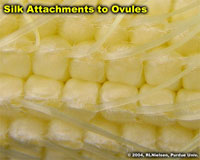
Silks (styles) attached to ovules on ear shoot.
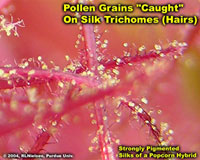
Pollen grains captured on trichomes or "hairs" of silks.
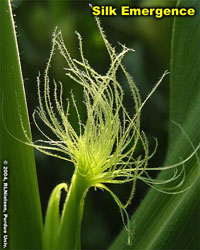
Silks emerging from husk leaves of ear shoot.
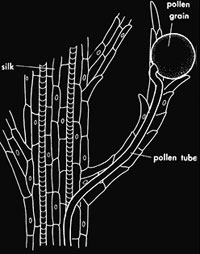
Schematic drawing of pollen tube development within a silk.
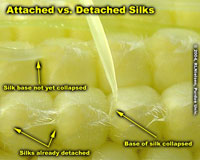
Closeup of attached vs detached silks.
Silk clipping by corn rootworm beetles, Japanese beetles, and other obnoxious critters during pollination can be severe enough to impede pollen capture and germination. While you may be tempted to apply insecticides at the first sign of these insects, Purdue entomologists tell us that treatment is not necessary unless the silks are being continuously clipped back to less than 1/2 inch long before pollination is 50 percent complete (Krupke et. al., 2005). Silk length is easy to measure, but how do you determine how the progress of pollination?
Obviously, one could wait impatiently until kernel development was visibly apparent. Within about 10 to 14 days after pollen shed, developing kernels will resemble white blisters on the cob (Nielsen, 2004). Unfortunately, by then any insect interference with the pollination process will have already taken its toll on kernel set. Luckily for us, the corn plant exhibits an earlier indicator of pollination progress.
Silk Detachment From Fertilized Ovules
Remember that each ovule (potential kernel) on the ear develops a silk (the functional “style” of the female flower) that elongates and eventually emerges through the ear’s husk leaves the tip of the ear shoot (Nielsen, 2005a). The silks represent the “pathway” for the male gametes in the pollen to fertilize the female gametes in the ovules.
Once a pollen grain is “captured” by a trichome or “hair” of a silk, the pollen grain germinates and develops a pollen tube that contains the male genetic material. The pollen tube penetrates the silk and, with adequate moisture and temperature, elongates down the length of the silk within 24 hours and fertilizes the ovule.
Within 2 to 3 days after an ovule has been successfully fertilized, the base of the silk will collapse and detach from the immature kernel. The kernel itself will usually not be recognizable to the naked eye at this stage. Silks of nonfertilized ovules remain attached, however, and will continue to lengthen and be receptive to pollen for up to 10 days after emergence from the ear shoot. Even if never fertilized, silks will remain attached to the ovules. Within days of full silk emergence, therefore, pollination progress may be estimated on individual ears by estimating percent silk detachment.
The Ear Shake Technique
For each ear, make a single lengthwise cut from the base of the ear shoot to the tip with a sharp knife, through the husk leaves to the cob. Slowly unwrap the husk leaves, taking care not to rip any silks from the ovules yourself. Then gently shake the ear. Silks of fertilized ovules will drop away; silks from unfertilized ovules will remain attached.
With practice, pollination progress can be easily determined by estimating the percentage of silks that fall away from the cob. Sampling several ears at random throughout a field will provide an indication of the progress of pollination for the whole field.
One Last Comment
While the “ear shake” technique helps you estimate pollination progress with respect to ovule fertilization, remember that pollination progress includes pollen shed progress. Check the tassels in early to mid-morning hours to determine whether anther exsertion and pollen shed are still occurring.
Remember, that anther exsertion and pollen shed typically begin on the central tassel stalk, then spreads progressively throughout the tassel branches (Nielsen, 2005b). If no further pollen shed is likely to occur, it doesn’t matter how badly those nasty insects are clipping silks. Unfertilized ovules will remain unfertilized ovules if there is no pollen left in the field. Spraying the bejeebers out of a field at that point is simply a costly form of revenge!
Related References
Krupke, Christian H., Larry W. Bledsoe, and John L. Obermeyer. 2005. Managing Corn Rootworms - 2005. Purdue Univ. Coop. Ext. Service Pub. No. E-49-W. Online at www.entm.purdue.edu/Entomology/ext/
targets/e-series/EseriesPDF/E-49.pdf [URL verified 7/4/05].
Nielsen, R.L. (Bob). 2004. Grain Fill Stages in Corn. Corny News Network, Purdue Univ. Online at www.kingcorn.org/news/articles.04/
GrainFill-0705.html [URL verified 7/4/05].
Nielsen, R.L. (Bob). 2005a. Silk Emergence. Corny News Network, Purdue Univ. Available online at www.kingcorn.org/news/articles.05/Silks-0704.html [URL verified 7/4/05].
Nielsen, R.L. (Bob). 2005b. Tassel Emergence & Pollen Shed. Corny News Network, Purdue Univ. Available online at www.kingcorn.org/news/articles.05/Tassels-0704.html [URL verified 7/4/05].

Closeup of attached vs. detached silks.
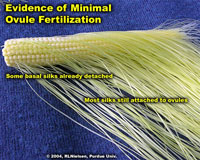
Ear with few detached silks, indicating little ovule fertilization
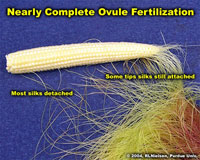
Ear with majority of silks detached indicating nearly complete ovule fertilization.
![]()
Tassel Emergence & Pollen Shed - (Bob Nielsen)
- Corn produces individual male and female flowers on the same plant.
- The tassel represents the mail flower of the corn plant.
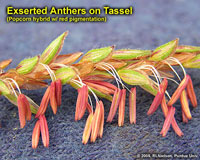
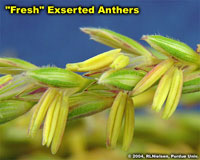

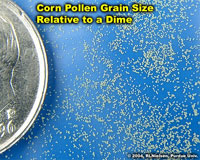
Over the next several weeks, the Indiana corn crop will move into the critical flowering stages of pollen shed and silk emergence. Success or failure during this period of the corn plant’s life will greatly influence the potential yield at harvest time.
As important as this process is to the determination of grain yield, it is surprising how little some folks know about the whole thing. Rather than leaving you to learn about such things “in the streets”, I’ve developed this article and the accompanying one on silking (Nielsen, 2005b) that describe the ins and outs of sex in the corn field.
Remember that corn has both male flowers and female flowers on the same plant (a flowering habit called monoecious for you trivia fans.) Interestingly, both flowers are initially bisexual (aka “perfect”), but during the course of development the female components (gynoecia) of the male flowers and the male components (stamens) of the female flowers abort, resulting in tassel (male) and ear (female) development.
Technically, growth stage VT occurs when the last branch of the tassel emerges from the whorl (Ritchie et. al., 1993). Portions of the tassel may be visible before the maximum leaf stage (final visible leaf collar) has occurred. Plant height is nearly at its maximum at growth stage VT. Pollen shed may begin before the tassel has completely emerged from the whorl.
The corn plant is most vulnerable to hail damage at growth stage VT since all of its leaves have emerged. Complete (100%) leaf loss at growth stage VT will usually result in complete (100%) yield loss by harvest. Even if pollination is successful, the ear shoots will usually die because few leaves remain to produce the necessary carbohydrates (by photosynthesis) to complete grain fill.
An individual tassel produces approximately 6,000 pollen-bearing anthers, although hybrids can vary greatly for this number. The anthers are those ‘thingamajigs’ that hang from the tassel during pollination. Under a magnifying lens, anthers look somewhat like the double barrel of a shotgun. Approximately 1,000 individual spikelets form on each tassel and each one bears two florets encased in two large glumes. Each floret contains three anthers. An anther and its attached filament comprise the stamen of the male flower.
As these florets mature, elongation of the filaments helps exsert the anthers from the glumes. Pollen is dispersed through pores that open at the tips of the anthers. Pollen shed usually begins in the mid-portion of the central tassel spike and then progresses upward, downward and outward over time. Anthers typically emerge from the upper floret of the pair first, while those from lower floret typically emerge later the same day or on following days. Spent anthers eventually drop from the tassel and are sometimes mistaken for the pollen when observed on the leaves or ground.
The yellow or white “dust-like” pollen that falls from a tassel represents millions of individual, nearly microscopic, spherical, yellowish- or whitish translucent pollen grains. Estimates of the total number of pollen grains produced per tassel range from 2 to 25 million. Each pollen grain contains the male genetic material necessary for fertilizing the ovary of one potential kernel.
The outer membrane of a pollen grain is very thin. Once dispersed into the atmosphere, pollen grains remain viable for only a few minutes before they desiccate. Yet, with only a 15 mph wind, pollen grains can travel as far as 1⁄2 mile within those couple of minutes.
Therein lies the concern of the potential for pollen “drift” from a transgenic corn field to an adjacent non-transgenic corn field and the risk of transgenic “contamination” of grain intended for non-transgenic markets. The good news is that recent research suggests that the overwhelming majority of a corn field’s pollen load is shed in the field itself.
All of the pollen from a single anther may be released in as little as three minutes. All the anthers on an individual tassel may take as long as seven days to finish shedding pollen, although the greatest volume of pollen is typically shed during the second and third day of anther emergence. Because of natural field variability in plant development, a whole field may take as long as 14 days to complete pollen shed.
Peak pollen shed usually occurs in mid-morning. Some research indicates that pollen shed decreases after temperatures surpass 86°F. A second “flush” of pollen often occurs in late afternoon or evening as temperatures cool. Pollen shed may occur throughout most of the day under relatively cool, cloudy conditions.
Weather conditions influence pollen shed. If the anthers are wet, the pores will not open and pollen will not be released. Thus, on an average Indiana summer morning following a heavy evening dew, pollen shed will not begin until the dew dries and the anther pores open. Similarly, pollen is not shed during rainy conditions. Cool, humid temperatures delay pollen shed, while hot, dry conditions hasten pollen shed.
Extreme heat stress (100°F or greater) can kill corn pollen, but fortunately the plant avoids significant pollen loss by virtue of two developmental characteristics. First of all, corn pollen does not mature or shed all at once. Pollen maturity and shed occur over several days and up to two weeks. Therefore, a day or two of extreme heat usually does not affect the entire pollen supply. More importantly, the majority of daily pollen shed occurs in the morning hours when air temperature is much more moderate.
Related References
Kling, Jennifer G. and Gregory Edmeades. 1997. Morphology and growth of maize. IITA/CIMMYT Research Guide 9. Int’l Institute of Tropical Agriculture. Available online at www.iita.org/info/trn_mat/irg9/irg9.htm [URL verified 7/4/05].
Nielsen, R.L. (Bob). 2005a. A Fast & Accurate Pregnancy Test for Corn. Corny News Network, Purdue Univ. Available online at www.kingcorn.org/news/articles.05/EarShake-0704.html [URL verified 7/4/05].
Nielsen, R.L. (Bob). 2005b. Silk Emergence. Corny News Network, Purdue Univ. Available online at www.kingcorn.org/news/articles.05/Silks-0704.html [URL verified 7/4/05].
Ritchie, S.W., J.J. Hanway, and G.O. Benson. 1993. How a Corn Plant Develops. Iowa State Univ. Sp. Rpt. No. 48. On the Web at http://maize.agron.iastate.edu/corngrows.html (last verified 7/4/05).
Russell, W.A. and A.R. Hallauer. 1980. Corn. (a chapter in) Hybridization of Crop Plants. American Soc. of Agronomy-Crop Science Soc. of America. Madison, WI.![]()
Silk Emergence – (Bob Nielsen)
- Corn Produces individual male and female flowers on the same plant.
- The ear represents the female flower of the corn plant.
- Severe soil moisture deficits can delay silk emergence and disrupt the synchrony of pollen shed and silk availability, resulting in poor kernel set.
As important as the process of pollination is to the determination of grain yield in corn, it is surprising how little some folks know about the details of cornfield sex. Rather than leaving you to learn about such things “in the streets”, take to read this article and the accompanying one on tassels and anthers (Nielsen, 2005b) that describe the ins and outs of this critical period of the corn plant’s life cycle.
The corn plant produces individual male and female flowers (a flowering habit called monoecious for you corny trivia fans.) Interestingly, both flowers are initially bisexual (aka “perfect”), but during the course of development the female components (gynoecia) of the male flowers and the male components (stamens) of the female flowers abort, resulting in tassel (male) and ear (female) development.
The silks that emerge from the ear shoot are the functional stigmas of the female flowers of a corn plant. Each silk connects to an individual ovule (potential kernel). A given silk must be pollinated in order for the ovule to be fertilized and develop into a kernel. Up to 1000 ovules typically form per ear, even though we typically harvest only 400 to 600 actual kernels per ear.
Technically, growth stage R1 (Ritchie et. al., 1993) for a given ear is defined when a single silk strand is visible from the tip of the husk. A field is defined as being at growth stage R1 when silks have emerged on at least 50 % of the plants.
Silk Elongation and Emergence
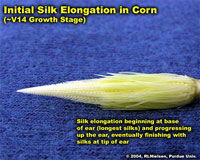
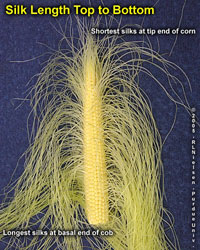
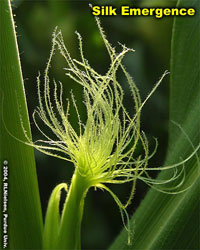
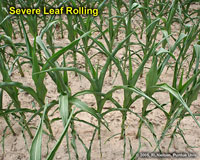
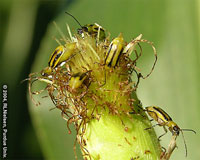
Silks begin to elongate from the ovules about 10 days prior to growth stage R1. Silk elongation begins first from the basal ovules of the cob, then proceeds sequentially up the ear. Similarly, silks from the basal (butt) portion of the ear typically emerge first from the husk, while the tip silks generally emerge last. Complete silk emergence from an ear generally occurs within four to eight days after the first silks appear.
As silks first emerge from the husk, they lengthen as much as 1.5 inches per day for the first day or two, but gradually slow over the next several days. Silk elongation occurs by expansion of existing cells, so elongation rate slows as more and more cells reach maximum size. Once pollinated, elongation of an individual silk will stop.
Silk elongation stops about 10 days after silk emergence, regardless of whether pollination occurs, due to senescence of the silk tissue. Unusually long silks can be a diagnostic symptom that the ear was not successfully pollinated.
Silks remain receptive to pollen grain germination up to 10 days after silk emergence, but to an ever-decreasing degree. Natural senescence of silk over time results in collapsed tissue that restricts continued growth of the pollen tube. Silk emergence usually occurs in close synchrony with pollen shed, so that duration of silk receptivity is normally not a concern. Failure of silks to emerge in the first place, however, does not bode well for successful pollination.
Pollination and Fertilization
For those of you serious about semantics, let’s review two definitions relevant to sex in the cornfield. Pollination is the act of transferring the pollen grains to the silks by wind or insects. Fertilization is the union of the male gametes from the pollen with the female gametes from the ovule. Technically, pollination is almost always successful (i.e., the pollen reaches the silks), but unsuccessful fertilization (i.e., pollen tube failure, silk failure, pollen death) will fail to result in a kernel.
Pollen grain germination occurs within minutes after a pollen grain lands on a receptive silk. A pollen tube, containing the male genetic material, develops and grows inside the silk, and fertilizes the ovule within 24 hours. Pollen grains can land and germinate anywhere along the length of an exposed receptive silk. Many pollen grains may germinate on a receptive silk, but typically only one will successfully fertilize the ovule.
Silk Emergence Failure
Severe Drought Stress. The most common cause of incomplete silk emergence is severe drought stress. Silks have the greatest water content of any corn plant tissue and thus are most sensitive to moisture levels in the plant. Severe moisture deficits will slow silk elongation, causing a delay or failure of silks to emerge from the ear shoot. If the delay is long enough, pollen shed may be almost or completely finished before receptive silks are available; resulting in nearly blank or totally blank cobs. Severe drought stress accompanied by low relative humidity can also desiccate exposed silks and render them non-receptive to pollen germination.
The severity of drought stress required for significant silk emergence delay or desiccation can probably be characterized by severe leaf rolling that begins early in the morning and continues into the early evening hours. Such severe leaf rolling is often accompanied by a change in leaf color from “healthy” green to a grayish-tinged green that may eventually die and bleach to a straw color.
Silk Clipping by Insects. Although technically not defined as silk emergence failure, severe silk clipping by insects such as corn rootworm beetle or Japanese beetle nonetheless can interfere with the success of pollination by decreasing or eliminating viable or receptive exposed silk tissue. Fortunately, unless the beetle activity is nonstop for days, continued elongation of silks from the husk will expose undamaged and receptive silk tissue at the rate of about one inch or more per day.
Related References
Kling, Jennifer G. and Gregory Edmeades. 1997. Morphology and growth of maize. IITA/CIMMYT Research Guide 9. Int’l Institute of Tropical Agriculture. Available online at www.iita.org/info/trn_mat/irg9/irg9.htm [URL verified 7/4/05].
Nielsen, R.L. (Bob). 2005a. A Fast & Accurate Pregnancy Test for Corn. Corny News Network, Purdue Univ. Available online at www.kingcorn.org/news/articles.05/EarShake-0704.html [URL verified 7/4/05].
Nielsen, R.L. (Bob). 2005b. Tassel Emergence & Pollen Shed. Corny News Network, Purdue Univ. Available online at www.kingcorn.org/news/articles.05/Tassels-0704.html [URL verified 7/4/05].
Ritchie, S.W., J.J. Hanway, and G.O. Benson. 1993. How a Corn Plant Develops. Iowa State Univ. Sp. Rpt. No. 48. On the Web at http://maize.agron.iastate.edu/corngrows.html (last verified 7/4/05).
Russell, W.A. and A.R. Hallauer. 1980. Corn. (a chapter in) Hybridization of Crop Plants. American Soc. of Agronomy-Crop Science Soc. of America. Madison, WI.
Steffey, Kevin. 2005. Rootworm Adults and Silk Clipping. Pest & Crop Bulletin, Univ. of Illinois. Available online at www.ipm.uiuc.edu/bulletin/article.php?issueNumber=15&issueYear=2005&articleNumber=2 [URL verified 7/4/05].
For other Corny News Network articles, browse through the CNN Archives at http://www.kingcorn.org/news/archive.html. For other information about corn, take a look at the Corn Growers’ Guidebook at http://www.kingcorn.org.
![]()

